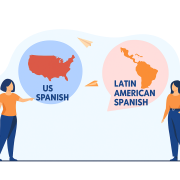Why US Spanish Deserves Its Own Place in Communication
Why US Spanish Deserves Its Own Place in Communication
Written by Paula Penovi, CT, CMI,
MA in Medical and Healthcare Translation
Spanish is spoken across dozens of countries, but the Spanish used every day in the United States has grown into its own variant. It reflects the voices of millions of people who live, study, work, and receive services here. Yet this variant is often overlooked and treated as if peninsular or generalized Latin American Spanish were automatically enough. When organizations rely on those varieties alone, they miss the linguistic reality of the communities they want to reach.
What Makes US Spanish Different
US Spanish is shaped by bilingual environments, constant contact with English, and the mix of origins within the Hispanic population. Families in the US come from Mexico, the Caribbean, Central America, South America, and Spain, and their speech blends into a shared, neutral, practical way of communicating. Neutrality is important because it helps messages reach people from many backgrounds without regional expressions or country-specific terms that could confuse readers. US Spanish favors simple structures, accessible vocabulary, and forms that feel natural to bilingual speakers who move between Spanish, English, and Spanglish every day. It is not a simplified form of Spanish. It is a functional and inclusive variety shaped by its context.
Why the US Context Matters
The US is the second-largest Spanish-speaking country in the world, after Mexico, and it surpasses both Colombia and Spain in its number of Spanish speakers. This population is not linguistically uniform. It includes people from every Spanish-speaking region, plus US-born bilingual speakers who learned Spanish in a household shaped by English. Because of this diversity, Spanish-language communication in the US must be adapted to a broad range of reading levels, experiences, and cultural backgrounds. The US context also affects formatting standards. Dates follow the month-day-year pattern, numbers use US conventions, and units of measurement follow the American system rather than the metric system. Acronyms remain in English because the public sees them that way on signs, forms, and posters. This is true for terms like CDC, IRS, SSN, and SNAP, which should not be translated. In fields like healthcare, education, and government services, clarity is essential. When text sounds foreign, overly formal, or tied to another country’s norms, people may misunderstand instructions or miss important details, which affects safety, access, and trust.
The Role of Plain Language
US institutions work under clear standards that prioritize easy-to-understand communication. Federal agencies must follow the Plain Writing Act of 2010, which influences Spanish translations as well. US Spanish favors straightforward vocabulary, brief sentences, and verbs that express actions directly. It keeps a low register whenever possible so that messages are accessible to the widest audience, including people with limited literacy or limited English proficiency. In critical situations like medical care, social services, financial assistance, and emergency instructions, this makes information easier to follow and increases the chance that individuals can navigate, without confusion, a system that works in a language they do not understand.
Everyday Linguistic Choices That Matter
Small choices have a big impact. US Spanish avoids regional vocabulary that might confuse readers from other countries and favors clear, familiar terms that match how people speak in the US. Because English influence is strong, US Spanish shows a higher adoption of neologisms, calques, and terms that are more similar to their English counterparts. This is not a flaw. It reflects bilingual life and helps readers connect information with concepts they already know. In healthcare, for example, “ultrasonido” is often preferred over “ecografía” because it resembles the English term “ultrasound”. Common verbs like “hacer” (to do) replace higher-register verbs such as “elaborar”, “efectuar”, “realizar” or “llevar a cabo”, which are typically used in Latin America. These choices improve clarity, support immediate understanding, and reduce confusion.
Organizations Should Care
Using US Spanish is not just a linguistic preference. It is a strategy that improves comprehension, reduces errors, builds trust, and ensures compliance with federal guidelines. When Spanish-speaking audiences feel that a message reflects their environment and respects their experiences, engagement rises. Clear communication promotes equity and strengthens connections between organizations and the communities they serve.
Our Commitment
At Argentum Translations, we specialize in US Spanish and plain-language communication. We are a HUB-certified, women-owned company that works with certified translators who understand the linguistic and cultural expectations of the US Hispanic population. Our team combines accuracy, clarity, and cultural insight to produce translations that truly serve the people who depend on them.
If your organization needs certified translation services, write to us at info@argentumtranslations.com. We can help you communicate effectively with Spanish-speaking audiences across the United States.
References
- Real Academia Norteamericana de la Lengua Española (ANLE). Glosas: Revista de la Academia Norteamericana de la Lengua Española. Resources on US Spanish, language contact, and linguistic features of Spanish in the United States.
- Red Internacional de Universidades Lectoras para el Estudio del Español de los Estados Unidos (RIUSS). Publications on the development, characteristics, and sociolinguistic profile of US Spanish.
- Plainlanguage.gov. The Plain Writing Act of 2010 and federal guidelines for clear communication used by US government agencies.
- Instituto Cervantes. Reports and studies on the global expansion of Spanish, including demographic data showing the growth of the Spanish-speaking population in the United States.
- Centers for Medicare & Medicaid Services (CMS). Readability and plain-language guidance for linguistically appropriate healthcare communication in the United States.
- US Census Bureau. Data on the Hispanic and Latino population in the US, including statistics on language use and Spanish speakers across the country.
Image disclaimer: This image was created with AI using ChatGPT. Argentum Translation holds no rights over the illustration, and it may be used freely as needed.

